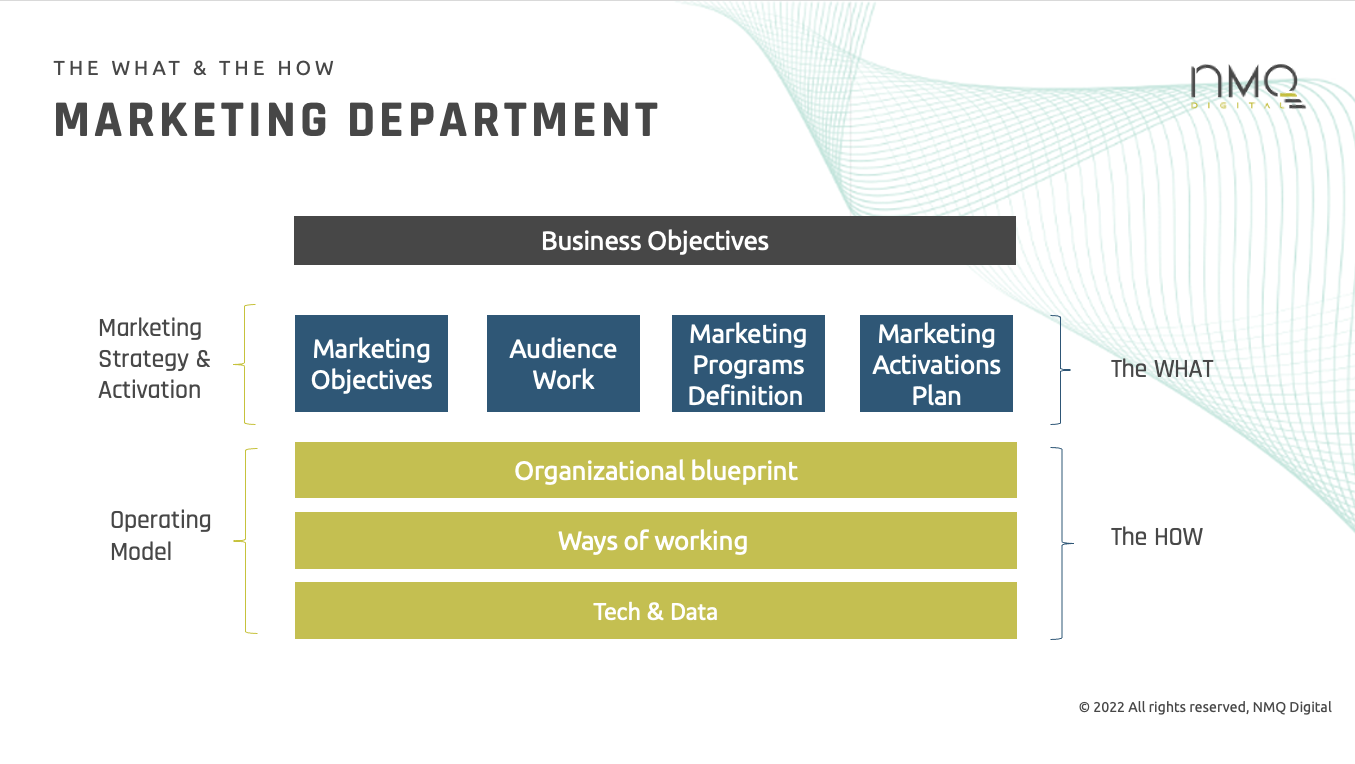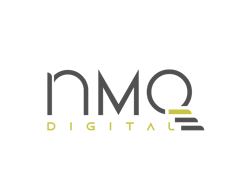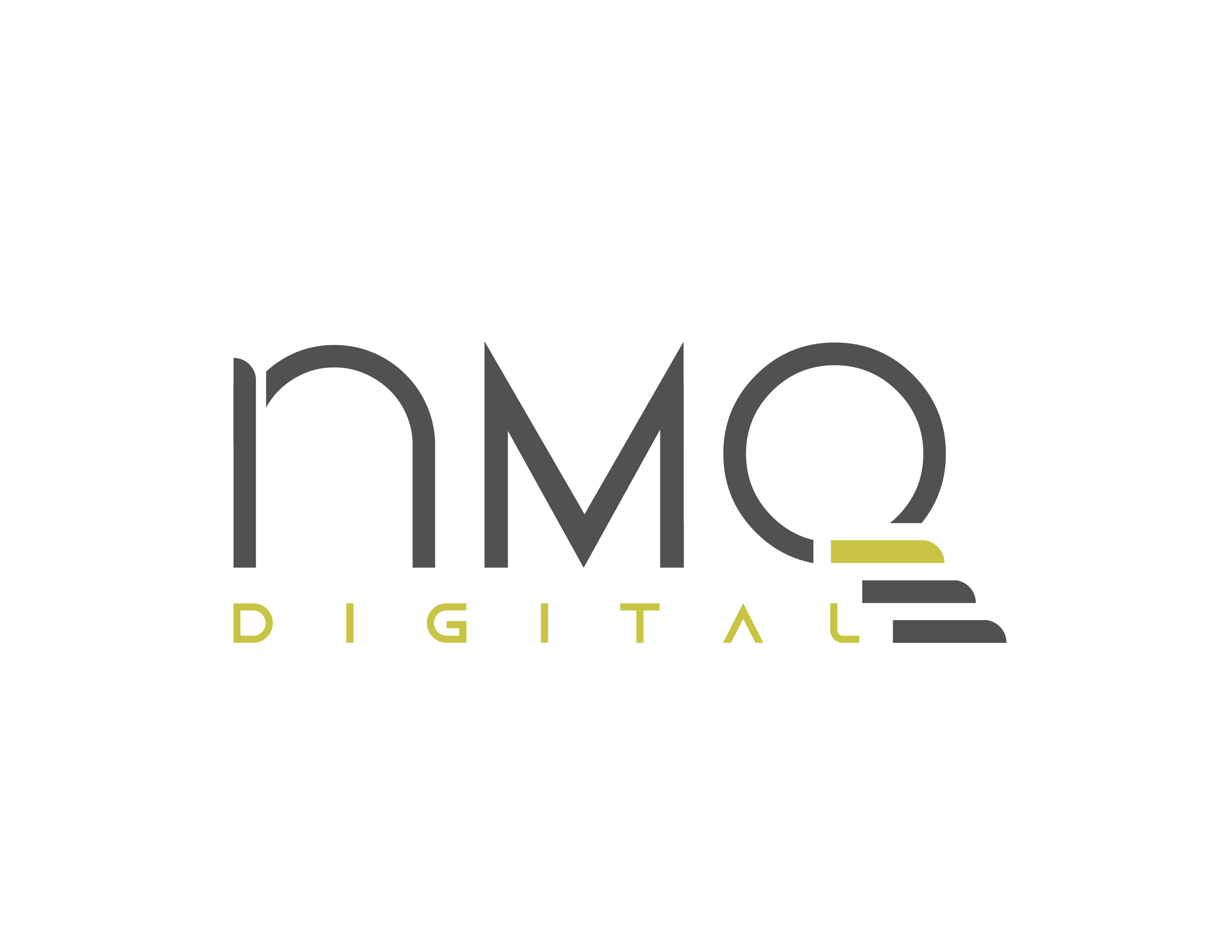If you are a CMO, a Head of Marketing, a Digital Team Lead, or a Marketing Manager, then this article is for you! Make sure to read as it can save you a serious amount of time and prevent you from making a couple of mistakes.
What this article answers:
- Where to start when building your marketing team or your marketing department
- What kind of tools & processes do you need to implement a data-driven Marketing Culture
- What are the most common pitfalls Marketeers fall into and how to avoid them
- A practical step-by-step approach to set up your operating model
Too busy to read? No problem! I have summarized for you the key takeaways from my article at the end. Just scroll straight to the executive summary.
0. The WHAT - Marketing Strategy & Activation vs the HOW - Operating model ( people, ways of working, technology)
I always like to start by drawing the below graph, which summarizes the life of a marketing department.
At the top are the business objectives you are asked to contribute to.
The blue boxes represent the pure Marketing work, from strategy to activation, and the green rectangles represent the 3 P’s of the operating model: People or the organizational chart, Process or the ways of working, and platforms, or the tools and technology we use.

Step 1: Translate Business Objectives into Marketing Objectives
My advice is to always start from the business objectives that your company needs to deliver, which in most cases are either: a revenue target, a market share target, or a profit target; and to translate them into a primary marketing objective which would be a number of clients, a number of prospects or a number of products sold.
Once you have your Primary Marketing Objective in place, you should define Secondary Marketing Objectives. Secondary Marketing objectives are smaller tangible goals that will help you reach your primary marketing objective.
Examples would be website visitors, conversion rate, positive product reviews, brand awareness etc. You have a lot of choices, but what matters is to stir your team in the same direction and to focus on the secondary objectives which will allow you to reach your Primary Marketing Objective.
Once you have targets in place, it’s tempting to dive straight into the action and in defining your marketing strategy (the WHAT).
This is a common pitfall Marketers fall into and here is why: you can’t deliver growth for the Business if you do not have the right talents and agency partners and the correct tools to measure what you do.
So I strongly invite you to look at the HOW and your operating model before doing that.
Step 2: Define your org chart & identify key roles & skillsets needed
Having the right talents and skillset is essential for your department’s success.
You want to ensure that key roles and associated skill sets are clearly identified and defined.
To find top talents, you need to know precisely what you are looking for!
So asking yourself questions like:
-what are the key roles & functions that I need to have in-house?
-what are the skill sets required for those roles?
- what are the soft skills this role needs; it’s not only about the technical skills, it’s also about how the person fits with the company culture and interacts with his/her colleagues
- does my current team have at least 70% of this skillset required or do they need to be trained on specific topics?
-what are the things that I can outsource/collaborate on with agencies or external partners? You can never have it all in-house, so you want to enter into partnerships with companies that act as an extension of your team
-That also may seem trivial but do not underestimate the importance of employee satisfaction. Attrition has a high cost for you and your team, and you want to make sure that you retain your talents for a couple of years. Now that we are all working mainly remotely, we tend to be very transactional in our meetings, but having a personal approach, bringing your team together, and building trust and relationship is essential for your employee satisfaction
Step 3: Get the right tools to know your customers, interact with them and measure their interaction with your business
I’m a strong believer in the data-driven approach and in measuring the full customer journey to understand what’s driven marketing ROI.
What gets measured gets done!
I’m also a big advocate of the test & learn culture because it avoids placing all your eggs in one basket, and gives you time to react & adjust based on real-life performance feedback.
Here is a list of tools you want to make sure to have in-house:
- Tag Manager such as Google Tag manager
- Web analytics tools such as Google Analytics
- Have a data layer in place to ensure high data quality & accurate data collection
- A CRM tool and audience management platforms such as Hubspot, Salesforce or Eloqua
- An A/B testing tool such as Optimizely
- (In house) Advertising licenses: Google 360, Adwords, Facebook Business Manager, Linkedin Business Manager
Making sure that you have the right Martech environment and license in-house to support you is essential.
Step 4: Define clear Roles & Responsibilities and build integrated ways of working
Integration is really key, a lot of times the different teams and departments are working in siloes, so no one really has the big picture of what clients and prospects are exposed to.
Having leaders who ensure good team collaboration across departments is essential.
I’m always a big advocate of having clear role descriptions and RACIs in place. You want to be crystal clear with your team about who is responsible for what and how they can best collaborate with other colleagues and teams.
You also want to go through the entire process and flow and identify each step to ensure nothing falls through the cracks. For example, let’s say you’re launching a paid advertising campaign, listing all the steps A to Z, from countries selection, budget allocation, audience definition, communication concepts, assets creation, media plans, landing pages, campaign trafficking, Q&A and go live etc.
The devil is always in the details, and investing time upfront in those will save you time and headaches after.
Step 5: Build your Marketing strategy
A good marketing strategy always has clear goals, is based on data, and has a solid understanding of your target audience.
In my view, customer journey research is essential, and investing upfront in analyzing your audience is a MUST. Many clients skip this part, but what could be more important than understanding who your target audience is, how they behave, how to talk to them, and where to find them?
Lastly, never forget to benchmark yourself against your competitors.
Step 6: Translate your Marketing strategy into activation Programs.
Activation programs are all sorts of initiatives & campaigns, paid & organic, which will help you reach & convert your audience.
It can be traffic generation through paid media, lead nurturing through CRM campaigns, thought leadership via content creation etc.
I won't get too much into detail on the marketing activations in this blog post, but more to come in the coming months on this topic.
Et voila, you’re ready to get things done and deliver growth for your Business!
Executive summary for busy people
- Marketing: the WHAT vs the HOW.
The WHAT is your Marketing strategy & activations, and the how is the 3P’s operating model: People, Process, Platforms. In other words: Org. Chart, Ways of working, and technology.
- Step-by-step summary to build a data-driven marketing department to deliver growth
- First, start with your Business Objectives as a north star and translate them into clear and actionable Marketing objectives. From those, it’s easy to build a coherent marketing strategy.
- Second, Avoid the pitfall of jumping straight into the what and planning your marketing activations, without having the HOW figured out, in other words, your operating model.
- Step 1: look at your org chart & identify key roles & skillsets needed
- Step 2: get the right tool to measure the customer journey and interact with your audience
- Step 3: you define clear roles & responsibilities of each team member and build integrated ways of working between teams and departments to avoid the unfamous silos
- Step 4: Think test & learn vs placing all your eggs in one basket. You want to have some speed and agility with a feedback loop to understand what works for your business
- Once you get this in place, you’re all set to jump into your Marketing activations
- Most common pitfalls Marketeers fall into and how to avoid them
- Jumping straight into the WHAT without having the HOW figured out
- Solution: refer to the step-by-step summary above
- Solution: refer to the step-by-step summary above
- Spending activation money without having proper measurement to understand what’s driving growth
- Solution: always track & measure the full customer journey before doing anything
- Solution: always track & measure the full customer journey before doing anything
- Placing all their eggs in one basket and going big with one marketing activation, without knowing if it works
- Solution: propose a test & learn
- Solution: propose a test & learn
- Being pushed by the Business to deliver immediate results when some things take time.
- Solution: propose a phased approach to gain time while showing traction with a small test & learn
- Working in siloes, without efficient integration and smart processes, spending more time doing work about work
- solution: integrated ways of working and clear RACI
- Employee burn-out & attrition
- solution: Employees need purpose and connection. Always give them clear job descriptions, KPI's and a clear understanding about how they contribute to the big picture. Lastly, don't forget about face-to-face connection time and team building.
- Jumping straight into the WHAT without having the HOW figured out





